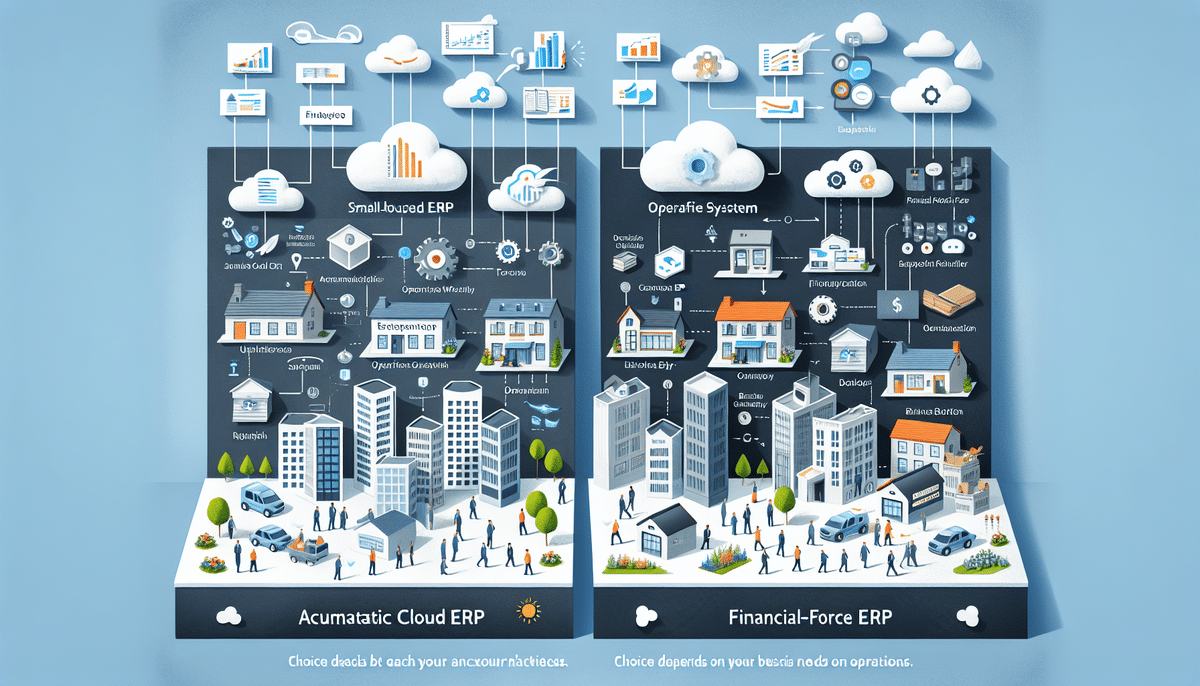Acumatica Cloud ERP vs FinancialForce ERP
Choosing the right Enterprise Resource Planning (ERP) system is crucial for business success. With a myriad of options ranging from traditional on-premise solutions to cutting-edge cloud-based platforms, selecting the best fit can be daunting. This article provides a comprehensive comparison between two leading cloud-based ERP systems: Acumatica Cloud ERP and FinancialForce ERP. We delve into their features, pricing models, implementation processes, customization capabilities, scalability, integration options, user experience, customer support, real-world case studies, and expert insights to aid you in making an informed decision.
Understanding Acumatica Cloud ERP
Acumatica Cloud ERP is a renowned cloud-based platform offering a wide array of integrated business management applications. These include financial management, distribution management, customer relationship management (CRM), project accounting, and project management. Tailored for small to mid-sized businesses, Acumatica combines the flexibility of cloud-based ERP with robust functionality and extensive customization.
A significant advantage of Acumatica is its seamless integration capabilities with other business applications and systems. This allows businesses to connect their ERP with CRM software, e-commerce platforms, and marketing automation tools, thereby streamlining processes and enhancing overall efficiency through facilitated data sharing and workflow automation.
For more information, visit the Acumatica Official Website.
Exploring FinancialForce ERP
FinancialForce ERP is a cloud-based financial management and ERP solution designed for mid-market organizations. It encompasses a comprehensive suite of business applications, including financial management, project management, revenue recognition, procurement, human capital management (HCM), and professional services automation (PSA). Built on the Salesforce platform, FinancialForce ERP is ideal for businesses already utilizing Salesforce, ensuring seamless ERP integration.
A notable benefit of FinancialForce ERP is its ability to provide real-time visibility into financial and operational data, enabling swift and informed decision-making. The platform features customizable dashboards and reports, allowing users to monitor key performance indicators (KPIs) and track business performance in real-time. With FinancialForce ERP, businesses can streamline operations, enhance collaboration, and maintain a competitive edge.
Learn more on the FinancialForce Official Website.
History and Background of Acumatica Cloud ERP
Founded in 2008 by Jon Roskill, Mike DeBacker, and Serguei Beloussov, Acumatica Cloud ERP was established to provide businesses with a scalable, cloud-based ERP alternative. Designed to eliminate the need for on-premise hardware or software, Acumatica allows businesses to manage operations from anywhere. In 2021, Silver Lake and Sopris Capital acquired a majority stake in Acumatica, further propelling its growth and innovation.
Since its inception, Acumatica has evolved into a leading cloud ERP solution, serving a diverse range of industries including manufacturing, distribution, retail, and services. The platform is recognized for its robust features, including financial management, project accounting, inventory management, and CRM.
Acumatica's success is driven by its commitment to continuous innovation and exceptional customer satisfaction. Regular updates and new feature releases ensure the platform remains at the forefront of the industry. Additionally, Acumatica emphasizes strong customer support, offering access to a dedicated support team and a comprehensive library of resources.
For more detailed history, refer to Acumatica's About Us page.
History and Background of FinancialForce ERP
FinancialForce ERP was established in 2009 by Jeremy Roche, primarily focusing on cloud-based accounting and financial management solutions. In 2011, FinancialForce partnered with Salesforce, leading to the development of FinancialForce as a native application on the Salesforce platform. This strategic partnership leverages Salesforce's robust capabilities, providing a comprehensive and integrated ERP solution.
Over the years, FinancialForce has expanded its offerings to include a wide range of applications that cater to the needs of mid-market organizations across various industries. The platform is celebrated for its real-time financial insights, project management capabilities, and seamless integration with Salesforce's ecosystem.
Discover more about FinancialForce's journey on their About Us page.
Key Features and Benefits of Acumatica Cloud ERP
Acumatica Cloud ERP offers a comprehensive suite of applications to manage financials, distribution, manufacturing, services, CRM, and project management. Key features include:
- Flexible Deployment Options: Cloud, on-premise, or hybrid deployments to suit diverse business needs.
- Advanced Financial Management: Comprehensive tools for general ledger, accounts payable/receivable, and cash management.
- Robust Project Management: Tools for project tracking, budgeting, and resource allocation.
- Powerful Business Intelligence (BI) and Reporting: Real-time dashboards and customizable reports for data-driven decisions.
- Scalable Architecture: Easily accommodate business growth with additional users, locations, and modules.
- Advanced Customization: Tailor workflows, add custom fields, and integrate third-party applications.
The benefits Acumatica provides to businesses include:
- Enhanced visibility over all business operations.
- Increased efficiency and productivity through automation.
- Cost reduction by minimizing manual processes.
- Improved collaboration across departments.
- Enhanced customer experience with better order fulfillment and service delivery.
For detailed feature lists, visit Acumatica Products.
Key Features and Benefits of FinancialForce ERP
FinancialForce ERP delivers a robust suite of business applications to manage financials, resource planning, professional services automation (PSA), and human capital management (HCM). Key features include:
- Native Salesforce Integration: Seamless connectivity with Salesforce CRM and other Salesforce products.
- Advanced Financial Management: Comprehensive tools for revenue recognition, budgeting, and forecasting.
- Professional Services Automation (PSA): Tools for project management, resource scheduling, and time tracking.
- Human Capital Management (HCM): Solutions for payroll, benefits administration, and employee management.
- Powerful BI and Analytics: Real-time insights and customizable reports for strategic decision-making.
- Flexible Billing and Invoicing: Various billing methods and automated invoicing processes.
The benefits FinancialForce offers to businesses include:
- Streamlined financial management and reporting.
- Improved resource planning and utilization.
- Enhanced automation leading to increased efficiency.
- Greater visibility and control over projects and finances.
- Improved customer engagement and satisfaction.
Explore more features on the FinancialForce Products page.
Pricing Models Comparison: Acumatica Cloud ERP vs FinancialForce ERP
Both Acumatica Cloud ERP and FinancialForce ERP offer flexible pricing models tailored to the unique needs of businesses.
Acumatica Cloud ERP employs a subscription-based pricing model where businesses pay based on the resources they consume, such as the number of users, data storage, and specific functionalities. This model allows for scalability without hefty upfront costs, making it an affordable choice for small and mid-sized businesses.
FinancialForce ERP also utilizes a subscription-based pricing structure, typically based on a per-user, per-month fee. Additionally, FinancialForce offers a 14-day free trial, enabling businesses to evaluate the platform's functionalities before committing.
Both platforms provide customizable pricing options to accommodate various business sizes and requirements. It's advisable to contact their sales teams for tailored quotes based on specific business needs.
For more pricing details, visit Acumatica Pricing and FinancialForce Pricing.
Implementation Ease: Acumatica Cloud ERP vs FinancialForce ERP
Implementing a new ERP system can be a complex process, especially for businesses with limited IT resources. Both Acumatica Cloud ERP and FinancialForce ERP prioritize ease of implementation with user-friendly platforms that can be deployed rapidly with minimal disruption.
Acumatica Cloud ERP offers multiple implementation options, including cloud-based, on-premise, and hybrid deployments. This flexibility allows businesses to choose the deployment method that best aligns with their operational needs and IT infrastructure.
FinancialForce ERP, being a cloud-native solution built on the Salesforce platform, offers a streamlined implementation process, particularly for businesses already using Salesforce. The integration is seamless, reducing the time and effort required for deployment.
Both providers offer extensive support during the implementation phase, including professional services, training, and comprehensive documentation to ensure a smooth transition.
Customization Capabilities: Acumatica Cloud ERP vs FinancialForce ERP
Customization is a critical factor in selecting an ERP system, ensuring that the platform can adapt to specific business needs.
Acumatica Cloud ERP excels in customization by allowing businesses to add custom fields, create custom workflows, and integrate with third-party applications. The platform's open architecture and robust API support facilitate extensive modifications without disrupting core functionalities.
FinancialForce ERP, built on the Salesforce platform, offers unlimited customization potential. Businesses can leverage Salesforce's powerful customization tools to tailor the ERP system to their unique requirements. This includes creating custom objects, workflows, and integrating with a multitude of Salesforce-compatible applications.
Both platforms provide developer resources and support to assist in the customization process, ensuring that businesses can fully tailor the ERP system to their operational needs.
Scalability: Acumatica Cloud ERP vs FinancialForce ERP
Scalability is essential for growing businesses, ensuring that the ERP system can accommodate increasing demands and expansions.
Acumatica Cloud ERP's scalable architecture allows businesses to effortlessly add new users, locations, and applications as they grow. The platform is designed to support businesses of all sizes, from small enterprises to large organizations, without compromising performance.
FinancialForce ERP leverages Salesforce's robust infrastructure to offer unlimited scalability. Businesses can scale their operations seamlessly, whether expanding into new markets, adding new product lines, or increasing their workforce. The native integration with Salesforce ensures that scalability does not disrupt existing processes.
Both ERP systems are built to grow with the business, ensuring long-term viability and performance.
Integration Capabilities: Acumatica Cloud ERP vs FinancialForce ERP
Effective integration with other systems is vital for maintaining cohesive business operations.
Acumatica Cloud ERP provides extensive integration capabilities through open APIs, web services, and numerous pre-built integrations. This enables seamless connectivity with a wide range of third-party applications, including CRM systems, e-commerce platforms, and marketing tools.
FinancialForce ERP's native integration with the Salesforce platform allows for effortless connections with other Salesforce products, such as Sales Cloud and Service Cloud. Additionally, FinancialForce offers APIs and integration tools to connect with various other business applications.
Both platforms support robust integration frameworks, ensuring that businesses can maintain a unified and efficient technological ecosystem.
User Experience: Acumatica Cloud ERP vs FinancialForce ERP
The user experience (UX) of an ERP system significantly impacts its adoption and effectiveness within an organization.
Acumatica Cloud ERP boasts an intuitive and user-friendly interface that simplifies business management. The platform features a streamlined design, making it easy for users to navigate and locate necessary information quickly. Customizable dashboards allow users to personalize their data views, enhancing productivity and efficiency.
FinancialForce ERP inherits Salesforce's familiar and intuitive design, making it particularly user-friendly for those already accustomed to the Salesforce ecosystem. The interface is designed for ease of use, with customizable layouts and dashboards that cater to individual user preferences.
Both ERP systems prioritize user experience, offering interfaces that are both aesthetically pleasing and functionally efficient to promote user adoption and satisfaction.
Customer Support: Acumatica Cloud ERP vs FinancialForce ERP
Reliable customer support is crucial for troubleshooting issues and ensuring smooth ERP operations.
Acumatica Cloud ERP offers 24/7 customer support through various channels, including phone, email, and live chat. The support team is composed of experienced technicians who can assist with technical issues, implementation queries, and general troubleshooting. Additionally, Acumatica provides an extensive knowledge base, training resources, and user forums to support its customers.
FinancialForce ERP also delivers comprehensive customer support services. Their customer success program includes a dedicated account manager, access to a community of experts, and a wealth of online resources, including tutorials, documentation, and user forums. FinancialForce ensures that businesses receive timely and effective support to resolve any issues that arise.
Both platforms emphasize robust customer support, ensuring that businesses have the assistance they need to optimize their ERP systems.
Real-World Case Studies: Acumatica Cloud ERP vs FinancialForce ERP
Real-world case studies provide valuable insights into how businesses leverage ERP systems to enhance operations and drive growth.
- Acumatica Cloud ERP: A retail distributor reported a 25% improvement in order processing time after implementing Acumatica Cloud ERP. The system's inventory management and order fulfillment features streamlined operations, leading to increased efficiency and customer satisfaction.
- FinancialForce ERP: A professional services company achieved a 50% increase in project margins by adopting FinancialForce ERP. The platform's project management and PSA tools enabled better resource allocation and project tracking, resulting in higher profitability.
- Acumatica Cloud ERP: A manufacturing firm enhanced its production planning and inventory control, reducing excess inventory by 20% and improving production cycles.
- FinancialForce ERP: A mid-sized consultancy improved its financial reporting accuracy and reduced month-end closing time by 30% through FinancialForce's advanced financial management tools.
These case studies underscore the transformative impact that Acumatica Cloud ERP and FinancialForce ERP can have across different industries.
Expert Opinions: Industry Insights on Acumatica Cloud ERP vs FinancialForce ERP
Industry experts acknowledge that both Acumatica Cloud ERP and FinancialForce ERP are exemplary cloud-based ERP solutions. The optimal choice between the two hinges on specific business requirements and strategic goals.
For businesses seeking a highly customizable ERP platform with flexible deployment options, Acumatica Cloud ERP is often recommended. Its open architecture and extensive integration capabilities make it a versatile choice for diverse business needs.
Conversely, for businesses already entrenched in the Salesforce ecosystem, FinancialForce ERP is frequently favored. Its native Salesforce integration and robust PSA features make it an ideal choice for companies looking to enhance their Salesforce investments.
According to Gartner's 2023 ERP Magic Quadrant, both Acumatica and FinancialForce have been recognized for their innovation, customer satisfaction, and comprehensive feature sets.
Experts advise businesses to conduct thorough needs assessments and consider factors such as existing technology stacks, customization requirements, and scalability needs before making a decision.
Conclusion: Summary and Recommendations for Choosing Between Acumatica Cloud ERP and FinancialForce ERP
In summary, both Acumatica Cloud ERP and FinancialForce ERP are robust cloud-based ERP solutions that offer comprehensive applications to effectively manage business operations. The choice between them depends on several key factors tailored to your business needs:
- Customization Needs: If your business requires extensive customization and flexible deployment options, Acumatica is a strong contender.
- Existing Technology Stack: For businesses already utilizing Salesforce, FinancialForce's native integration offers a seamless experience.
- Scalability: Both platforms are highly scalable, but your specific growth plans may make one more suitable than the other.
- Pricing: Evaluate the subscription-based pricing models of both ERP systems to determine which aligns best with your budget.
- Implementation Ease: Consider the ease and speed of implementation based on your company's IT resources and expertise.
- User Experience: Assess the user interface and overall user experience to ensure it meets your team's needs.
- Customer Support: Reliable customer support is essential; both platforms offer comprehensive support, so choose based on your preferred support channels.
Ultimately, the decision should be based on a thorough analysis of your business's unique requirements, operational workflows, and long-term strategic goals. Engaging with both providers through demos and consultations can provide deeper insights, facilitating a well-informed choice that propels your business towards success.




















